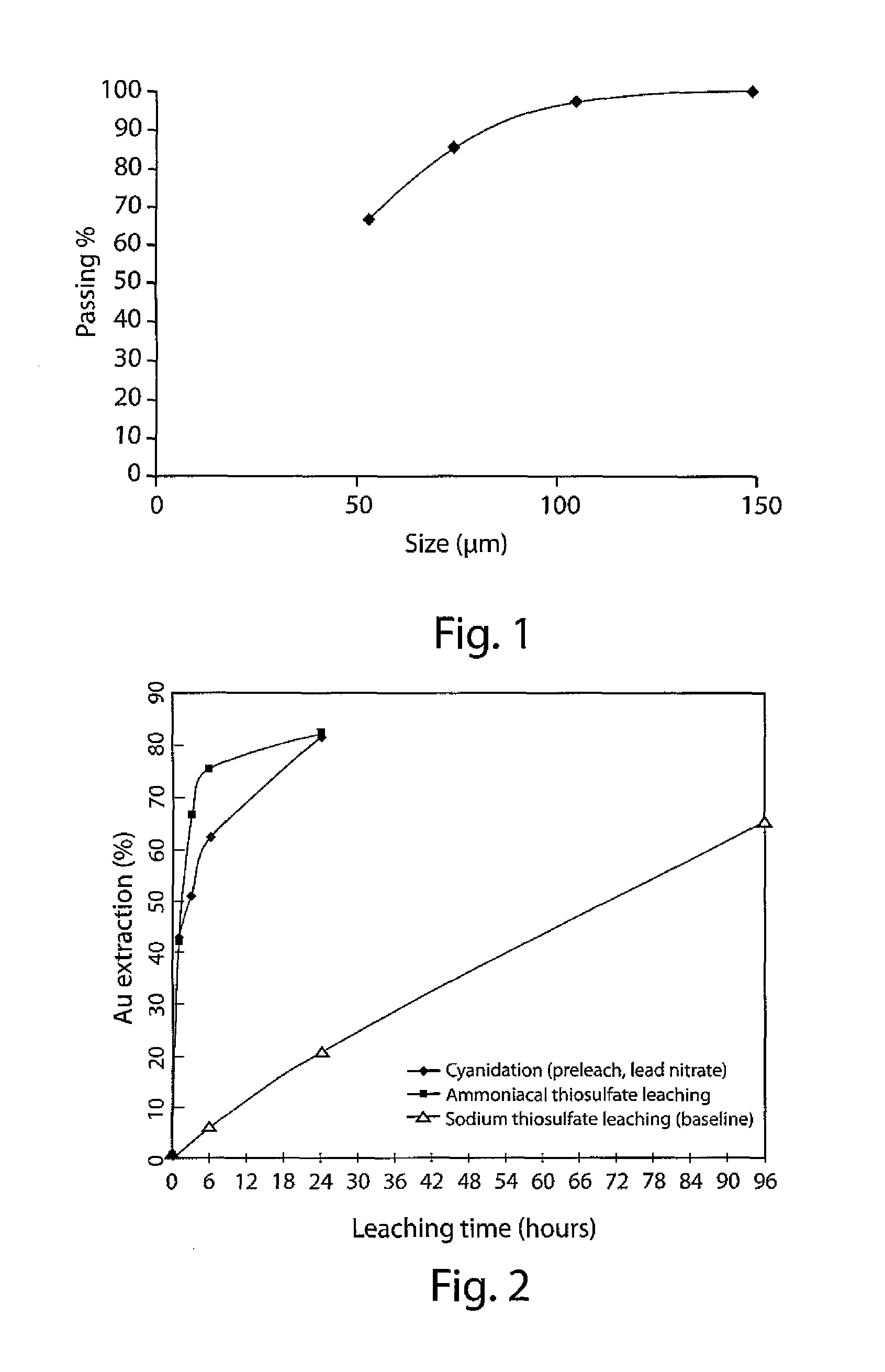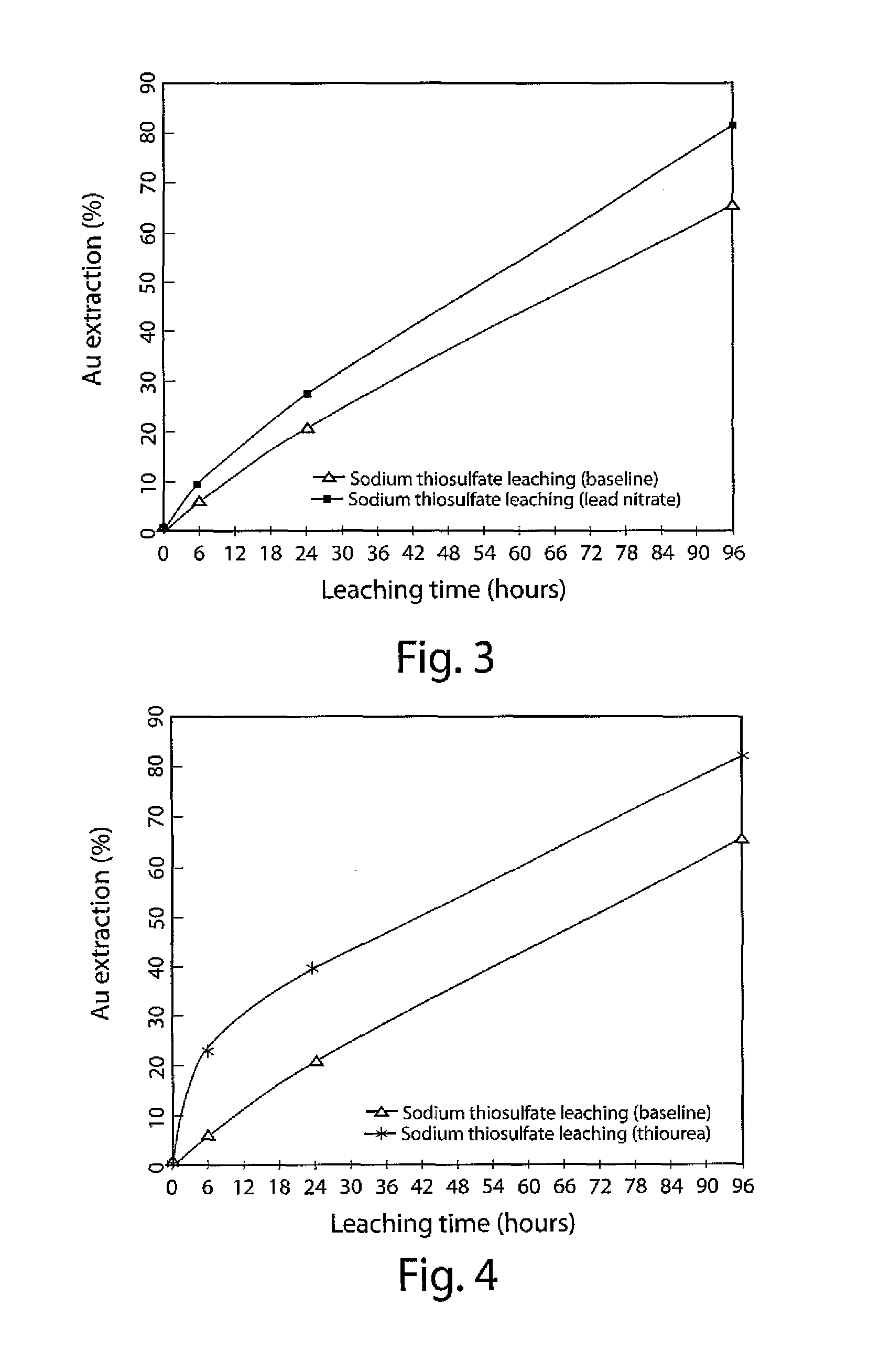Process of leaching precious metals
a precious metal and processing technology, applied in the field of leaching and recovering precious metals, can solve the problems of high poisonousness of cyanide to most life forms, cyanide process has become very controversial, criticized or restricted use, etc., and achieve the effect of increasing the rate or concentration of dissolved oxygen and accelerating the rate of precious metal extraction
- Summary
- Abstract
- Description
- Claims
- Application Information
AI Technical Summary
Benefits of technology
Problems solved by technology
Method used
Image
Examples
example 1
[0064]An ore sample used for this Example was a Cu / Pb / Zn-bearing sulphidic gold ore designated as “AEY” from Agnico-Eagle's Laronde mine. The mineralogical analysis showed that this sample contained 62.1% pyrite as the most abundant sulphide mineral. Chalcopyrite, pyrrhotite, galena and sphalerite were also found in this ore (see Table 1 below for full list of ore contents). Fire assays of the head sample indicated that there was an average of 1.4 g / t of gold in this sample.
[0065]
TABLE 1Mineral Composition of Tested OreMineralWt %Albite3.3Amphibole0.1Apatite0.03Arsenopyrite0.03Biotite2.6Calcite0.03Chalcopyrite0.1Chlorite0.2Epidote0.4Fe-Cralloy0.1Ferrohornblende1.3Galena0.6Illite3.7Ilmenite0.01Magnetite0.04Muscovite2.1Orthoclase0.3Pagioclase1.7Pyrite62.1Pyrrhotite3.7Quartz8.4Sphalerite8.8Tetrahedrite-0.1tennantiteTitanite0.1Total100
[0066]In this Example, both the basic sodium thiosulfate leaching process (no ammonia) and the enhanced sodium thiosulfate leaching processes (no ammonia,...
example 2
[0140]A high-grade oxide gold ore (−10 mesh or 2 mm) was obtained. The sample was divided evenly into 1.88-kg lots. Each lot was mixed with 1000 mL water and ground in a rod mill using stainless steel rods for 38 minutes. The wet screening analysis showed the particle size was reduced from −10 mesh (2 mm) to 82.6%-200 mesh (74 μm) after grinding.
[0141]Table 4 lists all the reagents and chemicals used in this work. The additions of cyanide and calcium hydroxide were in their solid powder form. The rest chemicals were added in the form of concentrated solutions.
[0142]
TABLE 4Chemicals and reagentsFormulaChemical NamesAbbreviationsPurityNa2S2O3•5H2Osodium thiosulfateSTS100.2% pentahydrate(NH4)2S2O3ammonium thiosulfateATS99%Ca(OH)2calcium hydroxide99%KIpotassium iodide99%I2Iodine99.8% CuSO4•5H2Ocopper sulfate pentahydrate99%AgNO3silver nitrate99%H2SO4sulfuric acid95%NH3, (NH4OH)ammonia, ammonium28-30%hydroxideC4H13N3diethylenetriamineDETA99%NaCNcyanide, sodium cyanide95%
[0143]The miner...
PUM
| Property | Measurement | Unit |
|---|---|---|
| pressure | aaaaa | aaaaa |
| temperature | aaaaa | aaaaa |
| temperature | aaaaa | aaaaa |
Abstract
Description
Claims
Application Information
 Login to View More
Login to View More - Generate Ideas
- Intellectual Property
- Life Sciences
- Materials
- Tech Scout
- Unparalleled Data Quality
- Higher Quality Content
- 60% Fewer Hallucinations
Browse by: Latest US Patents, China's latest patents, Technical Efficacy Thesaurus, Application Domain, Technology Topic, Popular Technical Reports.
© 2025 PatSnap. All rights reserved.Legal|Privacy policy|Modern Slavery Act Transparency Statement|Sitemap|About US| Contact US: help@patsnap.com



